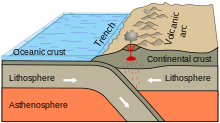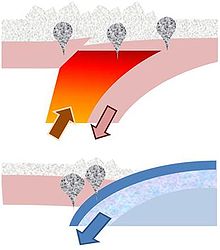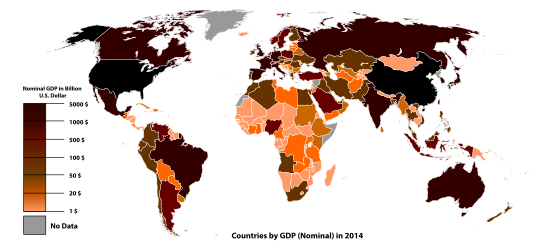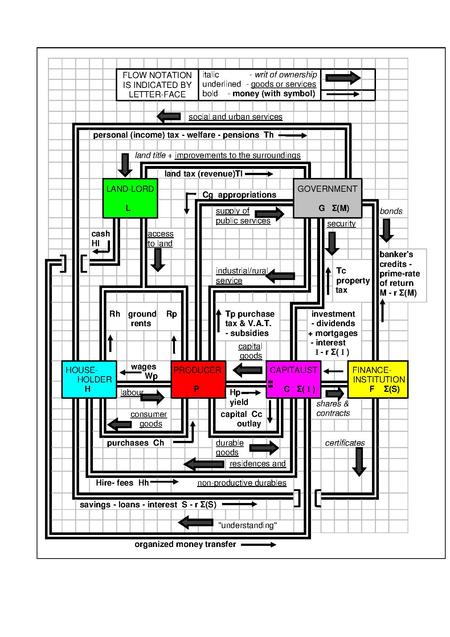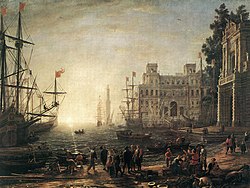From Wikipedia, the free encyclopedia
Countries by real GDP growth rate in 2016. Countries in red were in recession.
Economics (
)
[1][2][3] is the
social science that studies the
production,
distribution, and
consumption of
goods and services.
[4]
Economics focuses on the behaviour and interactions of
economic agents and how
economies work.
Microeconomics analyzes basic elements in the economy, including individual agents and
markets,
their interactions, and the outcomes of interactions. Individual agents
may include, for example, households, firms, buyers, and sellers.
Macroeconomics
analyzes the entire economy (meaning aggregated production,
consumption, savings, and investment) and issues affecting it, including
unemployment of resources (labour, capital, and land), inflation,
economic growth, and the public policies that address these issues
(monetary, fiscal, and other policies).
Other broad distinctions within economics include those between
positive economics, describing "what is", and
normative economics, advocating "what ought to be"; between economic theory and
applied economics; between
rational and
behavioural economics; and between
mainstream economics and
heterodox economics.
[5]
Term
The discipline was renamed in the late 19th century primarily due to
Alfred Marshall from "
political economy"
to "economics" as a shorter term for "economic science". At that time,
it became more open to rigorous thinking and made increased use of
mathematics, which helped support efforts to have it accepted as a
science and as a separate discipline outside of political science and
other social sciences.
[a][7][8][9] The ultimate goal of economics is to improve the living conditions of people in their everyday life.
[10]
Economic analysis can be applied throughout society, in
business,
finance,
health care, and government. Economic analysis is sometimes also applied to such diverse subjects as crime,
education,
[11] the
family,
law,
politics,
religion,
[12] social institutions, war,
[13] science,
[14] and
the environment.
[15]
Definitions
A map of world economies by size of GDP (nominal) in USD,
World Bank, 2014.
[16]
There are a variety of modern
definitions of economics; some reflect evolving views of the subject or different views among economists.
[17][18] Scottish philosopher
Adam Smith (1776) defined what was then called
political economy as "an inquiry into the nature and causes of the wealth of nations", in particular as:
a branch of the science of a statesman or legislator [with the
twofold objectives of providing] a plentiful revenue or subsistence for
the people ... [and] to supply the state or commonwealth with a revenue
for the publick services.[19]
Jean-Baptiste Say (1803), distinguishing the subject from its
public-policy uses, defines it as the science
of production, distribution, and consumption of
wealth.
[20] On the
satirical side,
Thomas Carlyle (1849) coined "
the dismal science" as an
epithet for
classical economics, in this context, commonly linked to the pessimistic analysis of
Malthus (1798).
[21] John Stuart Mill (1844) defines the subject in a social context as:
The science which traces the laws of such of the phenomena of society
as arise from the combined operations of mankind for the production of
wealth, in so far as those phenomena are not modified by the pursuit of
any other object.[22]
Alfred Marshall provides a still widely cited definition in his textbook
Principles of Economics (1890) that extends analysis beyond
wealth and from the
societal to the
microeconomic level:
Economics is a study of man in the ordinary business of life. It
enquires how he gets his income and how he uses it. Thus, it is on the
one side, the study of wealth and on the other and more important side, a
part of the study of man.[23]
Lionel Robbins (1932) developed implications of what has been termed "[p]erhaps the most commonly accepted current definition of the subject":
[18]
Economics is a science which studies human behaviour as a relationship between ends and scarce means which have alternative uses.[24]
Robbins describes the definition as not
classificatory in "pick[ing] out certain
kinds of behaviour" but rather
analytical in "focus[ing] attention on a particular
aspect of behaviour, the form imposed by the influence of
scarcity."
He affirmed that previous economists have usually centred their studies
on the analysis of wealth: how wealth is created (production),
distributed, and consumed; and how wealth can grow.
But he said that economics can be used to study other things, such as
war, that are outside its usual focus. This is because war has as the
goal winning it (as a sought after
end), generates both cost and benefits; and,
resources
(human life and other costs) are used to attain the goal. If the war is
not winnable or if the expected costs outweigh the benefits, the
deciding
actors (assuming they are rational) may never go to war (a
decision)
but rather explore other alternatives. We cannot define economics as
the science that studies wealth, war, crime, education, and any other
field economic analysis can be applied to; but, as the science that
studies a particular common aspect of each of those subjects (they all
use scarce resources to attain a sought after end).
Some subsequent comments criticized the definition as overly broad in
failing to limit its subject matter to analysis of markets. From the
1960s, however, such comments abated as the economic theory of
maximizing behaviour and
rational-choice modelling
expanded the domain of the subject to areas previously treated in other fields.
[27] There are other criticisms as well, such as in scarcity not accounting for the
macroeconomics of high unemployment.
[28]
Gary Becker,
a contributor to the expansion of economics into new areas, describes
the approach he favours as "combin[ing the] assumptions of maximizing
behaviour, stable
preferences, and
market equilibrium, used relentlessly and unflinchingly."
[29]
One commentary characterizes the remark as making economics an approach
rather than a subject matter but with great specificity as to the
"choice process and the type of
social interaction
that [such] analysis involves." The same source reviews a range of
definitions included in principles of economics textbooks and concludes
that the lack of agreement need not affect the subject-matter that the
texts treat. Among economists more generally, it argues that a
particular definition presented may reflect the direction toward which
the author believes economics is evolving, or should evolve.
[18]
Microeconomics
Markets
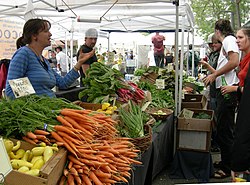
Economists study trade, production and consumption decisions, such as those that occur in a traditional
marketplace.
Microeconomics examines how entities, forming a
market structure, interact within a
market to create a
market system.
These entities include private and public players with various
classifications, typically operating under scarcity of tradable units
and light
government regulation. The item traded may be a tangible
product such as apples or a
service such as repair services, legal counsel, or entertainment.
In theory, in a
free market the
aggregates (sum of) of
quantity demanded by buyers and
quantity supplied by sellers may reach
economic equilibrium
over time in reaction to price changes; in practice, various issues may
prevent equilibrium, and any equilibrium reached may not necessarily be
morally equitable. For example, if the supply of healthcare services is limited by
external factors, the equilibrium price may be unaffordable for many who desire it but cannot pay for it.
Various market structures exist. In
perfectly competitive markets, no participants are large enough to have the
market power
to set the price of a homogeneous product. In other words, every
participant is a "price taker" as no participant influences the price of
a product. In the real world, markets often experience
imperfect competition.
Forms include
monopoly (in which there is only one seller of a good),
duopoly (in which there are only two sellers of a good), oligopoly (in which there are few sellers of a good),
monopolistic competition (in which there are many sellers producing highly differentiated goods),
monopsony (in which there is only one buyer of a good), and
oligopsony
(in which there are few buyers of a good). Unlike perfect competition,
imperfect competition invariably means market power is unequally
distributed. Firms under imperfect competition have the potential to be
"price makers", which means that, by holding a disproportionately high
share of market power, they can influence the prices of their products.
Microeconomics studies individual markets by simplifying the economic
system by assuming that activity in the market being analysed does not
affect other markets. This method of analysis is known as
partial-equilibrium analysis (supply and demand). This method aggregates (the sum of all activity) in only one market.
General-equilibrium theory studies various markets and their behaviour. It aggregates (the sum of all activity) across
all markets. This method studies both changes in markets and their interactions leading towards equilibrium.
[30]
Production, cost, and efficiency
In microeconomics,
production is the conversion of
inputs into
outputs. It is an economic process that uses inputs to create a
commodity or a service for
exchange or direct use. Production is a
flow and thus a rate of output per period of time. Distinctions include such production alternatives as for
consumption (food, haircuts, etc.) vs.
investment goods (new tractors, buildings, roads, etc.),
public goods (national defence, smallpox vaccinations, etc.) or
private goods (new computers, bananas, etc.), and
"guns" vs "butter".
Opportunity cost is the
economic cost of production: the value of the next best opportunity foregone. Choices must be made between desirable yet
mutually exclusive actions. It has been described as expressing "the basic relationship between
scarcity and
choice".
[31]
For example, if a baker uses a sack of flour to make pretzels one
morning, then the baker cannot use either the flour or the morning to
make bagels instead. Part of the cost of making pretzels is that neither
the flour nor the morning are available any longer, for use in some
other way. The opportunity cost of an activity is an element in ensuring
that scarce resources are used efficiently, such that the cost is
weighed against the value of that activity in deciding on more or less
of it. Opportunity costs are not restricted to monetary or financial
costs but could be measured by the
real cost of
output forgone,
leisure, or anything else that provides the alternative benefit (
utility).
[32]
Inputs used in the production process include such primary
factors of production as
labour services,
capital (durable produced goods used in production, such as an existing factory), and
land (including natural resources). Other inputs may include
intermediate goods used in production of final goods, such as the steel in a new car.
Economic efficiency measures how well a system generates desired output with a given set of inputs and available
technology.
Efficiency is improved if more output is generated without changing
inputs, or in other words, the amount of "waste" is reduced. A widely
accepted general standard is
Pareto efficiency, which is reached when no further change can make someone better off without making someone else worse off.
The
production–possibility frontier (PPF) is an expository figure for representing scarcity, cost, and efficiency. In the simplest case an
economy
can produce just two goods (say "guns" and "butter"). The PPF is a
table or graph (as at the right) showing the different quantity
combinations of the two goods producible with a given technology and
total factor inputs, which limit feasible total output. Each point on
the curve shows
potential total output for the economy, which is the maximum feasible output of one good, given a feasible output quantity of the other good.
Scarcity is represented in the figure by people being willing but unable in the aggregate to consume
beyond the PPF (such as at
X) and by the negative slope of the curve.
[33] If production of one good
increases along the curve, production of the other good
decreases, an
inverse relationship.
This is because increasing output of one good requires transferring
inputs to it from production of the other good, decreasing the latter.
The
slope of the curve at a point on it gives the
trade-off
between the two goods. It measures what an additional unit of one good
costs in units forgone of the other good, an example of a
real opportunity cost. Thus, if one more Gun costs 100 units of butter, the opportunity cost of one Gun is 100 Butter.
Along the PPF, scarcity implies that choosing
more of one good in the aggregate entails doing with
less of the other good. Still, in a
market economy, movement along the curve may indicate that the
choice of the increased output is anticipated to be worth the cost to the agents.
By construction, each point on the curve shows
productive efficiency in maximizing output for given total inputs. A point
inside the curve (as at
A), is feasible but represents
production inefficiency (wasteful use of inputs), in that output of
one or both goods could increase by moving in a northeast direction to a point on the curve. Examples cited of such inefficiency include high
unemployment during a
business-cycle recession or economic organization of a country that discourages full use of resources. Being on the curve might still not fully satisfy
allocative efficiency (also called
Pareto efficiency) if it does not produce a mix of goods that consumers prefer over other points.
Much
applied economics in
public policy
is concerned with determining how the efficiency of an economy can be
improved. Recognizing the reality of scarcity and then figuring out how
to organize society for the most efficient use of resources has been
described as the "essence of economics", where the subject "makes its
unique contribution."
[34]
Specialization
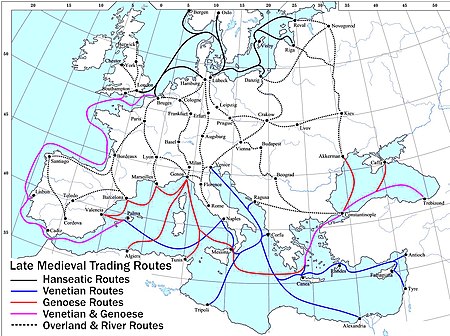
Specialization is considered key to economic efficiency based on theoretical and
empirical
considerations. Different individuals or nations may have different
real opportunity costs of production, say from differences in
stocks of
human capital per worker or
capital/
labour ratios. According to theory, this may give a
comparative advantage in production of goods that make more intensive use of the relatively more abundant, thus
relatively cheaper, input.
Even if one region has an
absolute advantage
as to the ratio of its outputs to inputs in every type of output, it
may still specialize in the output in which it has a comparative
advantage and thereby gain from trading with a region that lacks any
absolute advantage but has a comparative advantage in producing
something else.
It has been observed that a high volume of trade occurs among regions
even with access to a similar technology and mix of factor inputs,
including high-income countries. This has led to investigation of
economies of
scale and
agglomeration
to explain specialization in similar but differentiated product lines,
to the overall benefit of respective trading parties or regions.
[35]
The general theory of specialization applies to trade among individuals, farms, manufacturers,
service providers, and
economies. Among each of these production systems, there may be a corresponding
division of labour with different work groups specializing, or correspondingly different types of
capital equipment and differentiated
land uses.
[36]
An example that combines features above is a country that specializes
in the production of high-tech knowledge products, as developed
countries do, and trades with developing nations for goods produced in
factories where labour is relatively cheap and plentiful, resulting in
different in opportunity costs of production. More total output and
utility thereby results from specializing in production and trading than
if each country produced its own high-tech and low-tech products.
Theory and observation set out the conditions such that market
prices of outputs and productive inputs select an allocation of factor inputs by comparative advantage, so that (relatively)
low-cost inputs go to producing low-cost outputs. In the process, aggregate output may increase as a
by-product or by
design.
[37] Such specialization of production creates opportunities for
gains from trade whereby resource owners benefit from
trade in the sale of one type of output for other, more highly valued goods. A measure of gains from trade is the
increased income levels that trade may facilitate.
[38]
Supply and demand

The
supply and demand
model describes how prices vary as a result of a balance between
product availability and demand. The graph depicts an increase (that is,
right-shift) in demand from D
1 to D
2 along with the consequent increase in price and quantity required to reach a new equilibrium point on the supply curve (S).
Prices and quantities have been described as the most directly observable attributes of goods produced and exchanged in a
market economy.
[39]
The theory of supply and demand is an organizing principle for
explaining how prices coordinate the amounts produced and consumed. In
microeconomics, it applies to price and output determination for a market with
perfect competition, which includes the condition of no buyers or sellers large enough to have price-setting
power.
For a given market of a
commodity,
demand
is the relation of the quantity that all buyers would be prepared to
purchase at each unit price of the good. Demand is often represented by a
table or a graph showing price and quantity demanded (as in the
figure).
Demand theory describes individual consumers as
rationally
choosing the most preferred quantity of each good, given income,
prices, tastes, etc. A term for this is "constrained utility
maximization" (with income and
wealth as the
constraints on demand). Here,
utility
refers to the hypothesized relation of each individual consumer for
ranking different commodity bundles as more or less preferred.
The
law of demand
states that, in general, price and quantity demanded in a given market
are inversely related. That is, the higher the price of a product, the
less of it people would be prepared to buy (other things
unchanged). As the price of a commodity falls, consumers move toward it from relatively more expensive goods (the
substitution effect). In addition,
purchasing power from the price decline increases ability to buy (the
income effect). Other factors can change demand; for example an increase in income will shift the demand curve for a
normal good
outward relative to the origin, as in the figure. All determinants are
predominantly taken as constant factors of demand and supply.
Supply is the relation between the price of a good and the
quantity available for sale at that price. It may be represented as a
table or graph relating price and quantity supplied. Producers, for
example business firms, are hypothesized to be
profit-maximizers,
meaning that they attempt to produce and supply the amount of goods
that will bring them the highest profit. Supply is typically represented
as a function relating price and quantity, if other factors are
unchanged.
That is, the higher the price at which the good can be sold, the more
of it producers will supply, as in the figure. The higher price makes
it profitable to increase production. Just as on the demand side, the
position of the supply can shift, say from a change in the price of a
productive input or a technical improvement. The "Law of Supply" states
that, in general, a rise in price leads to an expansion in supply and a
fall in price leads to a contraction in supply. Here as well, the
determinants of supply, such as price of substitutes, cost of
production, technology applied and various factors inputs of production
are all taken to be constant for a specific time period of evaluation of
supply.
Market equilibrium
occurs where quantity supplied equals quantity demanded, the
intersection of the supply and demand curves in the figure above. At a
price below equilibrium, there is a shortage of quantity supplied
compared to quantity demanded. This is posited to bid the price up. At a
price above equilibrium, there is a surplus of quantity supplied
compared to quantity demanded. This pushes the price down. The
model
of supply and demand predicts that for given supply and demand curves,
price and quantity will stabilize at the price that makes quantity
supplied equal to quantity demanded. Similarly, demand-and-supply theory
predicts a new price-quantity combination from a shift in demand (as to
the figure), or in supply.
For a given quantity of a consumer good, the point on the demand curve indicates the value, or
marginal utility, to consumers for that unit. It measures what the consumer would be prepared to pay for that unit.
[40] The corresponding point on the supply curve measures
marginal cost,
the increase in total cost to the supplier for the corresponding unit
of the good. The price in equilibrium is determined by supply and
demand. In a
perfectly competitive market, supply and demand equate marginal cost and marginal utility at equilibrium.
[41]
On the supply side of the market, some factors of production are described as (relatively)
variable in the
short run,
which affects the cost of changing output levels. Their usage rates can
be changed easily, such as electrical power, raw-material inputs, and
over-time and temp work. Other inputs are relatively
fixed, such as plant and equipment and key personnel. In the
long run, all inputs may be adjusted by
management. These distinctions translate to differences in the
elasticity
(responsiveness) of the supply curve in the short and long runs and
corresponding differences in the price-quantity change from a shift on
the supply or demand side of the market.
Marginalist theory, such as above, describes the consumers as attempting to reach most-preferred positions, subject to
income and
wealth
constraints while producers attempt to maximize profits subject to
their own constraints, including demand for goods produced, technology,
and the price of inputs. For the consumer, that point comes where
marginal utility of a good, net of price, reaches zero, leaving no net
gain from further consumption increases. Analogously, the producer
compares
marginal revenue (identical to price for the perfect competitor) against the
marginal cost of a good, with
marginal profit
the difference. At the point where marginal profit reaches zero,
further increases in production of the good stop. For movement to market
equilibrium and for changes in equilibrium, price and quantity also
change "at the margin": more-or-less of something, rather than
necessarily all-or-nothing.
Other applications of demand and supply include the
distribution of income among the
factors of production, including labour and capital, through factor markets. In a competitive
labour market for example the quantity of labour employed and the price of labour (the wage rate) depends on the
demand for labour (from employers for production) and supply of labour (from potential workers).
Labour economics
examines the interaction of workers and employers through such markets
to explain patterns and changes of wages and other labour income,
labour mobility, and (un)employment, productivity through
human capital, and related public-policy issues.
[42]
Demand-and-supply analysis is used to explain the behaviour of
perfectly competitive markets, but as a standard of comparison it can be
extended to any type of market. It can also be generalized to explain
variables across the
economy, for example, total output (estimated as
real GDP) and the general
price level, as studied in
macroeconomics.
[43] Tracing the
qualitative
and quantitative effects of variables that change supply and demand,
whether in the short or long run, is a standard exercise in
applied economics.
Economic theory may also specify conditions such that supply and demand
through the market is an efficient mechanism for allocating resources.
[44]
Firms
People frequently do not trade directly on markets. Instead, on the supply side, they may work in and produce through
firms. The most obvious kinds of firms are
corporations,
partnerships and
trusts. According to
Ronald Coase, people begin to organize their production in firms when the costs of doing business becomes lower than doing it on the market.
[45] Firms combine labour and capital, and can achieve far greater
economies of scale (when the average cost per unit declines as more units are produced) than individual market trading.
In
perfectly competitive markets studied in the theory of supply and demand, there are many producers, none of which significantly influence price.
Industrial organization
generalizes from that special case to study the strategic behaviour of
firms that do have significant control of price. It considers the
structure of such markets and their interactions. Common market
structures studied besides perfect competition include monopolistic
competition, various forms of oligopoly, and monopoly.
[46]
Managerial economics applies
microeconomic analysis to specific decisions in business firms or other management units. It draws heavily from quantitative methods such as
operations research and programming and from statistical methods such as
regression analysis in the absence of certainty and perfect knowledge. A unifying theme is the attempt to
optimize
business decisions, including unit-cost minimization and profit
maximization, given the firm's objectives and constraints imposed by
technology and market conditions.
[47]
Uncertainty and game theory
Uncertainty in economics is an unknown prospect of gain or loss, whether quantifiable as
risk or not. Without it, household behaviour would be unaffected by uncertain employment and income prospects,
financial and
capital markets would reduce to exchange of a single
instrument in each market period, and there would be no
communications industry.
[48] Given its different forms, there are various ways of representing uncertainty and modelling economic agents' responses to it.
[49]Game theory is a branch of
applied mathematics that considers
strategic interactions between agents, one kind of uncertainty. It provides a mathematical
foundation of
industrial organization,
discussed above, to model different types of firm behaviour, for
example in an oligopolistic industry (few sellers), but equally
applicable to wage negotiations,
bargaining,
contract design, and any situation where individual agents are few enough to have perceptible effects on each other. In
behavioural economics, it has been used to model the strategies
agents choose when interacting with others whose interests are at least partially adverse to their own.
[50]
In this, it generalizes maximization approaches developed to analyse market actors such as in the
supply and demand model and allows for incomplete information of actors. The field dates from the 1944 classic
Theory of Games and Economic Behavior by
John von Neumann and
Oskar Morgenstern. It has significant applications seemingly outside of economics in such diverse subjects as formulation of
nuclear strategies,
ethics,
political science, and
evolutionary biology.
[51]
Risk aversion
may stimulate activity that in well-functioning markets smooths out
risk and communicates information about risk, as in markets for
insurance, commodity
futures contracts, and
financial instruments.
Financial economics or simply
finance describes the allocation of financial resources. It also analyses the pricing of financial instruments, the
financial structure of companies, the efficiency and fragility of
financial markets,
[52] financial crises, and related government policy or
regulation.
[53]
Some market organizations may give rise to inefficiencies associated with uncertainty. Based on
George Akerlof's "
Market for Lemons" article, the
paradigm
example is of a dodgy second-hand car market. Customers without
knowledge of whether a car is a "lemon" depress its price below what a
quality second-hand car would be.
[54] Information asymmetry
arises here, if the seller has more relevant information than the buyer
but no incentive to disclose it. Related problems in insurance are
adverse selection, such that those at most risk are most likely to insure (say reckless drivers), and
moral hazard, such that insurance results in riskier behaviour (say more reckless driving).
[55]
Both problems may raise insurance costs and reduce efficiency by driving otherwise willing transactors from the market ("
incomplete markets").
Moreover, attempting to reduce one problem, say adverse selection by
mandating insurance, may add to another, say moral hazard.
Information economics, which studies such problems, has relevance in subjects such as insurance,
contract law,
mechanism design,
monetary economics, and
health care.
[55]
Applied subjects include market and legal remedies to spread or reduce
risk, such as warranties, government-mandated partial insurance,
restructuring or
bankruptcy law, inspection, and
regulation for quality and information disclosure.
[56][57]
Market failure
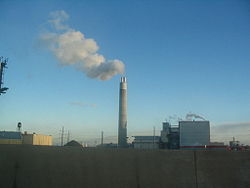
Pollution can be a simple example of market failure. If
costs of production are not borne by producers but are by the environment, accident victims or others, then prices are distorted.
The term "
market failure"
encompasses several problems which may undermine standard economic
assumptions. Although economists categorize market failures differently,
the following categories emerge in the main texts.
[b]
Information asymmetries and
incomplete markets
may result in economic inefficiency but also a possibility of improving
efficiency through market, legal, and regulatory remedies, as discussed
above.
Natural monopoly, or the overlapping concepts of "practical" and "technical" monopoly, is an extreme case of
failure of competition as a restraint on producers. Extreme
economies of scale are one possible cause.
Public goods
are goods which are undersupplied in a typical market. The defining
features are that people can consume public goods without having to pay
for them and that more than one person can consume the good at the same
time.
Externalities
occur where there are significant social costs or benefits from
production or consumption that are not reflected in market prices. For
example, air pollution may generate a negative externality, and
education may generate a positive externality (less crime, etc.). Governments often tax and otherwise restrict the sale of goods that have
negative externalities and subsidize or otherwise promote the purchase
of goods that have positive externalities in an effort to correct the
price
distortions caused by these externalities.
[58]
Elementary demand-and-supply theory predicts equilibrium but not the
speed of adjustment for changes of equilibrium due to a shift in demand
or supply.
In many areas, some form of
price stickiness
is postulated to account for quantities, rather than prices, adjusting
in the short run to changes on the demand side or the supply side. This
includes standard analysis of the
business cycle in
macroeconomics.
Analysis often revolves around causes of such price stickiness and
their implications for reaching a hypothesized long-run equilibrium.
Examples of such price stickiness in particular markets include wage
rates in labour markets and posted prices in markets
deviating from
perfect competition.
Some specialized fields of economics deal in market failure more than others. The
economics of the public sector is one example. Much
environmental economics concerns externalities or "
public bads".
Policy options include regulations that reflect
cost-benefit analysis or market solutions that change incentives, such as
emission fees or redefinition of property rights.
[60]
Public sector
Public finance is the field of economics that deals with
budgeting the revenues and expenditures of a
public sector entity, usually government. The subject addresses such matters as
tax incidence (who really pays a particular tax), cost-benefit analysis of government programmes, effects on
economic efficiency and
income distribution of different kinds of spending and taxes, and fiscal politics. The latter, an aspect of
public choice theory,
models public-sector behaviour analogously to microeconomics, involving
interactions of self-interested voters, politicians, and bureaucrats.
[61]
Much of economics is
positive, seeking to describe and predict economic phenomena.
Normative economics seeks to identify what economies
ought to be like.
Welfare economics is a normative branch of economics that uses
microeconomic techniques to simultaneously determine the
allocative efficiency within an economy and the income
distribution associated with it. It attempts to measure
social welfare by examining the economic activities of the individuals that comprise society.
[62]
Macroeconomics
The circulation of money in an economy in a macroeconomic model.
Macroeconomics examines the economy as a whole to explain broad
aggregates and their interactions "top down", that is, using a
simplified form of
general-equilibrium theory. Such aggregates include
national income and output, the
unemployment rate, and price
inflation and subaggregates like total consumption and investment spending and their components. It also studies effects of
monetary policy and
fiscal policy.
Since at least the 1960s, macroeconomics has been characterized by further integration as to
micro-based modelling of sectors, including
rationality of players,
efficient use of market information, and
imperfect competition.
[64] This has addressed a long-standing concern about inconsistent developments of the same subject.
[65]
Macroeconomic analysis also considers factors affecting the long-term level and
growth of national income. Such factors include capital accumulation,
technological change and
labour force growth.
Growth
Growth economics studies factors that explain
economic growth – the increase in output
per capita of a country over a long period of time. The same factors are used to explain differences in the
level of output per capita
between countries, in particular why some countries grow faster than others, and whether countries
converge at the same rates of growth.
Much-studied factors include the rate of
investment,
population growth, and
technological change. These are represented in theoretical and
empirical forms (as in the
neoclassical and
endogenous growth models) and in
growth accounting.
[67]
Business cycle
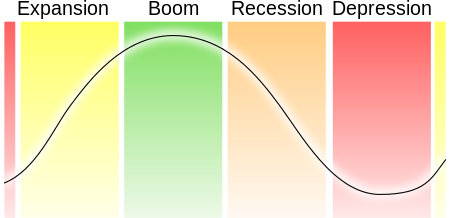
The economics of a depression were the spur for the creation of
"macroeconomics" as a separate discipline field of study. During the
Great Depression of the 1930s,
John Maynard Keynes authored a book entitled
The General Theory of Employment, Interest and Money outlining the key theories of
Keynesian economics. Keynes contended that
aggregate demand
for goods might be insufficient during economic downturns, leading to
unnecessarily high unemployment and losses of potential output.
He therefore advocated active policy responses by the
public sector, including
monetary policy actions by the
central bank and
fiscal policy actions by the government to stabilize output over the
business cycle.
[68]
Thus, a central conclusion of Keynesian economics is that, in some
situations, no strong automatic mechanism moves output and employment
towards
full employment levels.
John Hicks'
IS/LM model has been the most influential interpretation of
The General Theory.
Over the years, understanding of the
business cycle has branched into various
research programmes, mostly related to or distinct from Keynesianism. The
neoclassical synthesis refers to the reconciliation of Keynesian economics with
neoclassical economics, stating that Keynesianism is correct in the
short run but qualified by neoclassical-like considerations in the intermediate and
long run.
[69]
New classical macroeconomics, as distinct from the Keynesian view of the business cycle, posits
market clearing with
imperfect information. It includes Friedman's
permanent income hypothesis on consumption and "
rational expectations" theory,
[70] led by
Robert Lucas, and
real business cycle theory.
[71]
In contrast, the
new Keynesian approach retains the rational expectations assumption, however it assumes a variety of
market failures. In particular, New Keynesians assume prices and wages are "
sticky", which means they do not adjust instantaneously to changes in economic conditions.
[72]
Thus, the new classicals assume that prices and wages adjust
automatically to attain full employment, whereas the new Keynesians see
full employment as being automatically achieved only in the long run,
and hence government and central-bank policies are needed because the
"long run" may be very long.
Unemployment
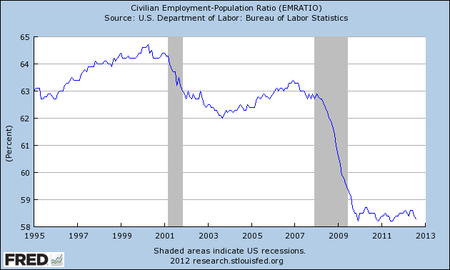
The amount of unemployment in an economy is measured by the
unemployment rate, the percentage of workers without jobs in the labour
force. The labour force only includes workers actively looking for jobs.
People who are retired, pursuing education, or
discouraged from seeking work
by a lack of job prospects are excluded from the labour force.
Unemployment can be generally broken down into several types that are
related to different causes.
[73]
Classical models of unemployment occurs when wages are too high for
employers to be willing to hire more workers. Wages may be too high
because of minimum wage laws or union activity. Consistent with
classical unemployment, frictional unemployment occurs when appropriate
job vacancies exist for a worker, but the length of time needed to
search for and find the job leads to a period of unemployment.
[73]
Structural unemployment
covers a variety of possible causes of unemployment including a
mismatch between workers' skills and the skills required for open jobs.
[74]
Large amounts of structural unemployment can occur when an economy is
transitioning industries and workers find their previous set of skills
are no longer in demand. Structural unemployment is similar to
frictional unemployment since both reflect the problem of matching
workers with job vacancies, but structural unemployment covers the time
needed to acquire new skills not just the short term search process.
While some types of unemployment may occur regardless of the
condition of the economy, cyclical unemployment occurs when growth
stagnates.
Okun's law represents the empirical relationship between unemployment and economic growth. The original version of Okun's law states that a 3% increase in output would lead to a 1% decrease in unemployment.
[77]
Inflation and monetary policy
Money is a
means of final payment for goods in most
price system economies, and is the
unit of account
in which prices are typically stated. Money has general acceptability,
relative consistency in value, divisibility, durability, portability,
elasticity in supply, and longevity with mass public confidence. It
includes currency held by the nonbank public and checkable deposits. It
has been described as a social convention, like language, useful to one
largely because it is useful to others. In the words of
Francis Amasa Walker, a well-known 19th-century economist, "Money is what money does" ("Money is
that money does" in the original).
[78]
As a
medium of exchange,
money facilitates trade. It is essentially a measure of value and more
importantly, a store of value being a basis for credit creation. Its
economic function can be contrasted with
barter (non-monetary exchange). Given a diverse array of produced goods and specialized producers, barter may entail a hard-to-locate
double coincidence of wants as to what is exchanged, say apples and a book. Money can reduce the
transaction cost
of exchange because of its ready acceptability. Then it is less costly
for the seller to accept money in exchange, rather than what the buyer
produces.
[79]
At the level of an
economy,
theory and evidence are consistent with a
positive relationship running from the total
money supply to the
nominal value of total output and to the general
price level. For this reason, management of the
money supply is a key aspect of
monetary policy.
[80]
Fiscal policy
Governments implement fiscal policy to influence macroeconomic
conditions by adjusting spending and taxation policies to alter
aggregate demand. When aggregate demand falls below the potential output
of the economy, there is an
output gap
where some productive capacity is left unemployed. Governments increase
spending and cut taxes to boost aggregate demand. Resources that have
been idled can be used by the government.
For example, unemployed home builders can be hired to expand
highways. Tax cuts allow consumers to increase their spending, which
boosts aggregate demand. Both tax cuts and spending have
multiplier effects where the initial increase in demand from the policy percolates through the economy and generates additional economic activity.
The effects of fiscal policy can be limited by
crowding out.
When there is no output gap, the economy is producing at full capacity
and there are no excess productive resources. If the government
increases spending in this situation, the government uses resources that
otherwise would have been used by the private sector, so there is no
increase in overall output. Some economists think that crowding out is
always an issue while others do not think it is a major issue when
output is depressed.
Sceptics of fiscal policy also make the argument of
Ricardian equivalence.
They argue that an increase in debt will have to be paid for with
future tax increases, which will cause people to reduce their
consumption and save money to pay for the future tax increase. Under
Ricardian equivalence, any boost in demand from tax cuts will be offset
by the increased saving intended to pay for future higher taxes.
International economics

List of countries by GDP (PPP) per capita in 2014.
International trade studies determinants of goods-and-services flows
across international boundaries. It also concerns the size and
distribution of
gains from trade. Policy applications include estimating the effects of changing
tariff rates and trade quotas.
International finance
is a macroeconomic field which examines the flow of capital across
international borders, and the effects of these movements on
exchange rates. Increased trade in goods, services and capital between countries is a major effect of contemporary
globalization.
[81]
Development economics
The distinct field of
development economics examines economic aspects of the
economic development process in relatively
low-income countries focusing on
structural change,
poverty, and
economic growth. Approaches in development economics frequently incorporate social and political factors.
[82]
Economic systems
Economic systems is the
branch of economics that studies the methods and
institutions by which societies determine the ownership, direction, and allocation of economic resources. An
economic system of a society is the unit of analysis.
Among contemporary systems at different ends of the organizational spectrum are
socialist systems and
capitalist systems, in which most production occurs in respectively state-run and private enterprises. In between are
mixed economies. A common element is the interaction of economic and political influences, broadly described as
political economy.
Comparative economic systems studies the relative performance and behaviour of different economies or systems.
[83]
The U.S. Export-Import Bank defines a Marxist-Lenninist state as having a centrally
planned economy.
[84] They are now rare; examples can still be seen in
Cuba,
North Korea and
Laos.
[85][needs update]
Practice
Contemporary economics uses mathematics. Economists draw on the tools of
calculus,
linear algebra,
statistics,
game theory, and
computer science.
[86]
Professional economists are expected to be familiar with these tools,
while a minority specialize in econometrics and mathematical methods.
Theory
Mainstream economic theory relies upon
a priori quantitative
economic models, which employ a variety of concepts. Theory typically proceeds with an assumption of
ceteris paribus,
which means holding constant explanatory variables other than the one
under consideration. When creating theories, the objective is to find
ones which are at least as simple in information requirements, more
precise in predictions, and more fruitful in generating additional
research than prior theories.
[87]
In
microeconomics, principal concepts include
supply and demand,
marginalism,
rational choice theory,
opportunity cost,
budget constraints,
utility, and the
theory of the firm.
[88] Early
macroeconomic
models focused on modeling the relationships between aggregate
variables, but as the relationships appeared to change over time
macroeconomists, including
new Keynesians, reformulated their models in
microfoundations.
[72]
The aforementioned microeconomic concepts play a major part in macroeconomic models – for instance, in
monetary theory, the
quantity theory of money predicts that increases in the growth rate of the
money supply increase
inflation, and inflation is assumed to be influenced by
rational expectations. In
development economics,
slower growth in developed nations has been sometimes predicted because
of the declining marginal returns of investment and capital, and this
has been observed in the
Four Asian Tigers. Sometimes an economic hypothesis is only
qualitative, not
quantitative.
[89]
Expositions of economic reasoning often use two-dimensional graphs to
illustrate theoretical relationships. At a higher level of generality,
Paul Samuelson's treatise
Foundations of Economic Analysis
(1947) used mathematical methods beyond graphs to represent the theory,
particularly as to maximizing behavioural relations of agents reaching
equilibrium. The book focused on examining the class of statements
called
operationally meaningful theorems in economics, which are
theorems that can conceivably be refuted by empirical data.
[90]
Empirical investigation
Economic theories are frequently tested
empirically, largely through the use of
econometrics using
economic data.
[91] The controlled experiments common to the
physical sciences are difficult and uncommon in economics,
[92] and instead broad data is
observationally studied;
this type of testing is typically regarded as less rigorous than
controlled experimentation, and the conclusions typically more
tentative. However, the field of
experimental economics is growing, and increasing use is being made of
natural experiments.
Statistical methods such as
regression analysis are common. Practitioners use such methods to estimate the size, economic significance, and
statistical significance
("signal strength") of the hypothesized relation(s) and to adjust for
noise from other variables. By such means, a hypothesis may gain
acceptance, although in a probabilistic, rather than certain, sense.
Acceptance is dependent upon the
falsifiable
hypothesis surviving tests. Use of commonly accepted methods need not
produce a final conclusion or even a consensus on a particular question,
given different tests,
data sets, and prior beliefs.
Criticisms based on professional standards and non-
replicability of results serve as further checks against bias, errors, and over-generalization,
although much economic research has been accused of being
non-replicable, and prestigious journals have been accused of not
facilitating replication through the provision of the code and data.
[95] Like theories, uses of test statistics are themselves open to critical analysis,
[96] although critical commentary on papers in economics in prestigious journals such as the
American Economic Review
has declined precipitously in the past 40 years. This has been
attributed to journals' incentives to maximize citations in order to
rank higher on the Social Science Citation Index (SSCI).
[97]
In applied economics,
input-output models employing
linear programming methods are quite common. Large amounts of data are run through computer programs to analyse the impact of certain policies;
IMPLAN is one well-known example.
Experimental economics has promoted the use of
scientifically controlled experiments. This has reduced the long-noted distinction of economics from
natural sciences because it allows direct tests of what were previously taken as axioms.
[98] In some cases these have found that the axioms are not entirely correct; for example, the
ultimatum game has revealed that people reject unequal offers.
In
behavioural economics, psychologist
Daniel Kahneman won the
Nobel Prize in economics in 2002 for his and
Amos Tversky's empirical discovery of several
cognitive biases and
heuristics. Similar empirical testing occurs in
neuroeconomics.
Another example is the assumption of narrowly selfish preferences
versus a model that tests for selfish, altruistic, and cooperative
preferences.
[99] These techniques have led some to argue that economics is a "genuine science".
[100]
Profession
The professionalization of economics, reflected in the growth of
graduate programmes on the subject, has been described as "the main
change in economics since around 1900".
[101] Most major
universities and many colleges have a major, school, or department in which
academic degrees are awarded in the subject, whether in the
liberal arts, business, or for professional study.
In the private sector, professional economists are employed as consultants and in industry, including
banking and
finance. Economists also work for various government departments and agencies, for example, the national
Treasury,
Central Bank or
Bureau of Statistics.
The
Nobel Memorial Prize in Economic Sciences
(commonly known as the Nobel Prize in Economics) is a prize awarded to
economists each year for outstanding intellectual contributions in the
field.
Related subjects
Economics is one
social science among several and has fields bordering on other areas, including
economic geography,
economic history,
public choice,
energy economics,
cultural economics,
family economics and
institutional economics.
Law and economics, or economic analysis of law, is an approach to
legal theory that applies methods of economics to law. It includes the
use of economic concepts to explain the effects of legal rules, to
assess which legal rules are
economically efficient, and to predict what the legal rules will be.
[102] A seminal article by
Ronald Coase published in 1961 suggested that well-defined property rights could overcome the problems of
externalities.
[103]
Political economy is the interdisciplinary study that combines economics, law, and
political science in explaining how political institutions, the political environment, and the economic system (capitalist,
socialist, mixed) influence each other. It studies questions such as how monopoly,
rent-seeking behaviour, and
externalities should impact government policy.
[104] Historians have employed
political economy
to explore the ways in the past that persons and groups with common
economic interests have used politics to effect changes beneficial to
their interests.
[105]
Energy economics is a broad
scientific subject area which includes topics related to
energy supply and
energy demand.
Georgescu-Roegen reintroduced the concept of
entropy in relation to economics and energy from
thermodynamics,
as distinguished from what he viewed as the mechanistic foundation of
neoclassical economics drawn from Newtonian physics. His work
contributed significantly to
thermoeconomics and to
ecological economics. He also did foundational work which later developed into
evolutionary economics.
[106]
The
sociological subfield of
economic sociology arose, primarily through the work of
Émile Durkheim,
Max Weber and
Georg Simmel, as an approach to analysing the effects of economic phenomena in relation to the overarching social paradigm (i.e.
modernity).
[107] Classic works include
Max Weber's
The Protestant Ethic and the Spirit of Capitalism (1905) and
Georg Simmel's
The Philosophy of Money (1900). More recently, the works of
Mark Granovetter,
Peter Hedstrom and
Richard Swedberg have been influential in this field.
History
Economic writings date from earlier
Mesopotamian,
Greek,
Roman,
Indian subcontinent,
Chinese,
Persian, and
Arab civilizations. Economic precepts occur throughout the writings of the
Boeotian poet
Hesiod and several economic historians have described Hesiod himself as the "first economist".
[108] Other notable writers from
Antiquity through to the
Renaissance include
Aristotle,
Xenophon,
Chanakya (also known as Kautilya),
Qin Shi Huang,
Thomas Aquinas, and
Ibn Khaldun.
Joseph Schumpeter described Aquinas as "coming nearer than any other group to being the "founders' of scientific economics" as to
monetary, interest, and
value theory within a
natural-law perspective.
[109][not in citation given]
A 1638 painting of a French seaport during the heyday of
mercantilism.
Two groups, later called "mercantilists" and "physiocrats", more
directly influenced the subsequent development of the subject. Both
groups were associated with the rise of
economic nationalism and
modern capitalism in Europe.
Mercantilism
was an economic doctrine that flourished from the 16th to 18th century
in a prolific pamphlet literature, whether of merchants or statesmen. It
held that a nation's wealth depended on its accumulation of gold and
silver. Nations without access to mines could obtain gold and silver
from trade only by selling goods abroad and restricting imports other
than of gold and silver. The doctrine called for importing cheap raw
materials to be used in manufacturing goods, which could be exported,
and for state regulation to impose protective tariffs on foreign
manufactured goods and prohibit manufacturing in the colonies.
[110]
Physiocrats, a group of 18th-century French thinkers and writers, developed the idea of the economy as a
circular flow
of income and output. Physiocrats believed that only agricultural
production generated a clear surplus over cost, so that agriculture was
the basis of all wealth. Thus, they opposed the mercantilist policy of
promoting manufacturing and trade at the expense of agriculture,
including import tariffs. Physiocrats advocated replacing
administratively costly tax collections with a single tax on income of
land owners. In reaction against copious mercantilist trade regulations,
the physiocrats advocated a policy of
laissez-faire, which called for minimal government intervention in the economy.
[111]
Adam Smith (1723–1790) was an early economic theorist.
[112]
Smith was harshly critical of the mercantilists but described the
physiocratic system "with all its imperfections" as "perhaps the purest
approximation to the truth that has yet been published" on the subject.
[113]
Classical political economy
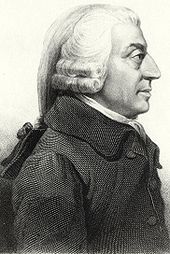
The publication of Adam Smith's
The Wealth of Nations in 1776, has been described as "the effective birth of economics as a separate discipline."
The book identified land, labour, and capital as the three factors of
production and the major contributors to a nation's wealth, as distinct
from the physiocratic idea that only agriculture was productive.
Smith discusses potential benefits of specialization by
division of labour, including increased
labour productivity and
gains from trade, whether between town and country or across countries.
[115] His "theorem" that "the division of labor is limited by the extent of the market" has been described as the "core of a
theory of the functions of firm and
industry" and a "fundamental principle of economic organization."
[116] To Smith has also been ascribed "the most important substantive proposition in all of economics" and foundation of
resource-allocation theory – that, under
competition,
resource owners (of labour, land, and capital) seek their most
profitable uses, resulting in an equal rate of return for all uses in
equilibrium (adjusted for apparent differences arising from such factors as training and unemployment).
[117]
In an argument that includes "one of the most famous passages in all economics,"
[118]
Smith represents every individual as trying to employ any capital they
might command for their own advantage, not that of the society,
[c]
and for the sake of profit, which is necessary at some level for
employing capital in domestic industry, and positively related to the
value of produce.
[120] In this:
He generally, indeed, neither intends to promote the public interest,
nor knows how much he is promoting it. By preferring the support of
domestic to that of foreign industry, he intends only his own security;
and by directing that industry in such a manner as its produce may be of
the greatest value, he intends only his own gain, and he is in this, as
in many other cases, led by an invisible hand to promote an end which
was no part of his intention. Nor is it always the worse for the society
that it was no part of it. By pursuing his own interest he frequently
promotes that of the society more effectually than when he really
intends to promote it.
The
Rev. Thomas Robert Malthus (1798) used the concept of
diminishing returns to explain low living standards.
Human population,
he argued, tended to increase geometrically, outstripping the
production of food, which increased arithmetically. The force of a
rapidly growing population against a limited amount of land meant
diminishing returns to labour. The result, he claimed, was chronically
low wages, which prevented the standard of living for most of the
population from rising above the subsistence level.
[122] Economist
Julian Lincoln Simon has criticized Malthus's conclusions.
[123]
While Adam Smith emphasized the production of income,
David Ricardo
(1817) focused on the distribution of income among landowners, workers,
and capitalists. Ricardo saw an inherent conflict between landowners on
the one hand and labour and capital on the other. He posited that the
growth of population and capital, pressing against a fixed supply of
land, pushes up rents and holds down wages and profits. Ricardo was the
first to state and prove the principle of
comparative advantage, according to which each country should specialize in producing and exporting goods in that it has a lower
relative cost of production, rather relying only on its own production.
[124] It has been termed a "fundamental analytical explanation" for
gains from trade.
[125]
Coming at the end of the classical tradition, John Stuart Mill (1848)
parted company with the earlier classical economists on the
inevitability of the distribution of income produced by the market
system. Mill pointed to a distinct difference between the market's two
roles: allocation of resources and distribution of income. The market
might be efficient in allocating resources but not in distributing
income, he wrote, making it necessary for society to intervene.
[126]
Value theory was important in classical theory. Smith wrote that the
"real price of every thing ... is the toil and trouble of acquiring it".
Smith maintained that, with rent and profit, other costs besides wages
also enter the price of a commodity. Other classical economists presented variations on Smith, termed the '
labour theory of value'. Classical economics focused on the tendency of any market economy to settle in a
final stationary state made up of a constant stock of physical wealth (capital) and a constant population size.
Marxism
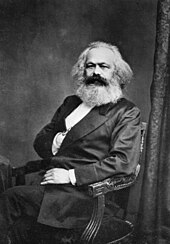
The Marxist school of economic thought comes from the work of German economist
Karl Marx.
Marxist (later, Marxian) economics descends from classical economics. It derives from the work of
Karl Marx. The first volume of Marx's major work,
Das Kapital, was published in German in 1867. In it, Marx focused on the
labour theory of value and the
theory of surplus value which, he believed, explained the exploitation of labour by capital.
[128]
The labour theory of value held that the value of an exchanged
commodity was determined by the labour that went into its production and
the theory of surplus value demonstrated how the workers only got paid a
proportion of the value their work had created.
[84]
Neoclassical economics
At the dawn as a social science,
economics was defined and
discussed at length as the study of production, distribution, and
consumption of wealth by Jean-Baptiste Say in his
Treatise on Political Economy or, The Production, Distribution, and Consumption of Wealth
(1803). These three items are considered by the science only in
relation to the increase or diminution of wealth, and not in reference
to their processes of execution.
[d]
Say's definition has prevailed up to our time, saved by substituting
the word "wealth" for "goods and services" meaning that wealth may
include non-material objects as well. One hundred and thirty years
later,
Lionel Robbins noticed that this definition no longer sufficed,
[e] because many economists were making theoretical and philosophical inroads in other areas of human activity. In his
Essay on the Nature and Significance of Economic Science,
he proposed a definition of economics as a study of a particular aspect
of human behaviour, the one that falls under the influence of scarcity,
[f]
which forces people to choose, allocate scarce resources to competing
ends, and economize (seeking the greatest welfare while avoiding the
wasting of scarce resources). For Robbins, the insufficiency was solved,
and his definition allows us to proclaim, with an easy conscience,
education economics, safety and security economics, health economics,
war economics, and of course, production, distribution and consumption
economics as valid subjects of the economic science."
Citing Robbins: "Economics is the science which studies human
behavior as a relationship between ends and scarce means which have
alternative uses".
After discussing it for decades, Robbins' definition became widely
accepted by mainstream economists, and it has opened way into current
textbooks.
[129]
Although far from unanimous, most mainstream economists would accept
some version of Robbins' definition, even though many have raised
serious objections to the scope and method of economics, emanating from
that definition.
Due to the lack of strong consensus, and that production, distribution
and consumption of goods and services is the prime area of study of
economics, the old definition still stands in many quarters.
A body of theory later termed "neoclassical economics" or "
marginalism" formed from about 1870 to 1910. The term "economics" was popularized by such neoclassical economists as
Alfred Marshall as a concise synonym for "economic science" and a substitute for the earlier "
political economy".
[8][9] This corresponded to the influence on the subject of mathematical methods used in the
natural sciences.
[131]
Neoclassical economics systematized
supply and demand
as joint determinants of price and quantity in market equilibrium,
affecting both the allocation of output and the distribution of income.
It dispensed with the
labour theory of value inherited from classical economics in favour of a
marginal utility theory of value on the demand side and a more general theory of costs on the supply side.
[132] In the 20th century, neoclassical theorists moved away from an earlier
notion suggesting that total utility for a society could be measured in
favour of
ordinal utility, which hypothesizes merely behaviour-based relations across persons.
[41][133]
In
microeconomics, neoclassical economics represents incentives and costs as playing a pervasive role in shaping
decision making. An immediate example of this is the
consumer theory of individual demand, which isolates how prices (as costs) and income affect quantity demanded.
[41] In
macroeconomics it is reflected in an early and lasting
neoclassical synthesis with Keynesian macroeconomics.
[69][134]
Neoclassical economics is occasionally referred as
orthodox economics whether by its critics or sympathizers. Modern
mainstream economics builds on neoclassical economics but with many refinements that either supplement or generalize earlier analysis, such as
econometrics,
game theory, analysis of
market failure and
imperfect competition, and the
neoclassical model of
economic growth for analysing long-run variables affecting
national income.
Neoclassical economics studies the behaviour of
individuals,
households, and
organizations (called economic actors, players, or agents), when they manage or use
scarce
resources, which have alternative uses, to achieve desired ends. Agents
are assumed to act rationally, have multiple desirable ends in sight,
limited resources to obtain these ends, a set of stable preferences, a
definite overall guiding objective, and the capability of making a
choice. There exists an economic problem, subject to study by economic
science, when a
decision
(choice) is made by one or more resource-controlling players to attain
the best possible outcome under bounded rational conditions. In other
words, resource-controlling agents maximize value subject to the
constraints imposed by the information the agents have, their cognitive
limitations, and the finite amount of time they have to make and execute
a decision. Economic science centres on the activities of the economic
agents that comprise society.
[135] They are the focus of economic analysis.
[g]
An approach to understanding these processes, through the study of agent behaviour under scarcity, may go as follows:
The continuous interplay (exchange or trade) done by economic actors
in all markets sets the prices for all goods and services which, in
turn, make the rational managing of scarce resources possible. At the
same time, the decisions (choices) made by the same actors, while they
are pursuing their own interest, determine the level of output
(production), consumption, savings, and investment, in an economy, as
well as the remuneration (distribution) paid to the owners of labour (in
the form of wages), capital (in the form of profits) and land (in the
form of rent).
[h]
Each period, as if they were in a giant feedback system, economic
players influence the pricing processes and the economy, and are in turn
influenced by them until a steady state (equilibrium) of all variables
involved is reached or until an external shock throws the system toward a
new equilibrium point. Because of the autonomous actions of rational
interacting agents, the economy is a complex adaptive system.
[i]
Keynesian economics
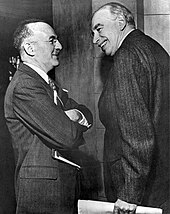
Keynesian economics derives from
John Maynard Keynes, in particular his book
The General Theory of Employment, Interest and Money (1936), which ushered in contemporary
macroeconomics as a distinct field.
[136]
The book focused on determinants of national income in the short run
when prices are relatively inflexible. Keynes attempted to explain in
broad theoretical detail why high labour-market unemployment might not
be self-correcting due to low "
effective demand"
and why even price flexibility and monetary policy might be unavailing.
The term "revolutionary" has been applied to the book in its impact on
economic analysis.
[137]
Keynesian economics has two successors.
Post-Keynesian economics
also concentrates on macroeconomic rigidities and adjustment processes.
Research on micro foundations for their models is represented as based
on real-life practices rather than simple optimizing models. It is
generally associated with the
University of Cambridge and the work of
Joan Robinson.
[138]
New-Keynesian economics
is also associated with developments in the Keynesian fashion. Within
this group researchers tend to share with other economists the emphasis
on models employing micro foundations and optimizing behaviour but with a
narrower focus on standard Keynesian themes such as price and wage
rigidity. These are usually made to be endogenous features of the
models, rather than simply assumed as in older Keynesian-style ones.
Chicago school of economics
The Chicago School of economics is best known for its free market advocacy and
monetarist ideas. According to
Milton Friedman and monetarists, market economies are inherently stable if the money supply does not greatly expand or contract.
Ben Bernanke,
former Chairman of the Federal Reserve, is among the economists today
generally accepting Friedman's analysis of the causes of the Great
Depression.
[139]
Milton Friedman effectively took many of the basic principles set
forth by Adam Smith and the classical economists and modernized them.
One example of this is his article in the 13 September 1970 issue of
The New York Times Magazine,
in which he claims that the social responsibility of business should be
"to use its resources and engage in activities designed to increase its
profits ... (through) open and free competition without deception or
fraud."
[140]
Other schools and approaches
Other well-known schools or trends of thought referring to a
particular style of economics practised at and disseminated from
well-defined groups of academicians that have become known worldwide,
include the
Austrian School, the
Freiburg School, the
School of Lausanne,
post-Keynesian economics and the
Stockholm school. Contemporary
mainstream economics is sometimes separated into the Saltwater approach of those universities along the
Eastern and
Western coasts of the US, and the Freshwater, or Chicago-school approach.
Within macroeconomics there is, in general order of their appearance in the literature;
classical economics,
Keynesian economics, the neoclassical synthesis,
post-Keynesian economics,
monetarism,
new classical economics, and
supply-side economics. Alternative developments include
ecological economics,
constitutional economics,
institutional economics,
evolutionary economics,
dependency theory,
structuralist economics,
world systems theory,
econophysics,
feminist economics and
biophysical economics.
[141]
Agreements
According to various random and anonymous surveys of members of the
American Economic Association, economists have agreement about the following propositions by percentage:
[142][143][144][145][146][147]
- A ceiling on rents reduces the quantity and quality of housing available. (93% agree)
- Tariffs and import quotas usually reduce general economic welfare. (93% agree)
- Flexible and floating exchange rates offer an effective international monetary arrangement. (90% agree)
- Fiscal policy (e.g., tax cut and/or government expenditure increase) has a significant stimulative impact on a less than fully employed economy. (90% agree)
- The United States should not restrict employers from outsourcing work to foreign countries. (90% agree)
- Economic growth in developed countries like the United States leads to greater levels of well-being. (88% agree)
- The United States should eliminate agricultural subsidies. (85% agree)
- An appropriately designed fiscal policy can increase the long-run rate of capital formation. (85% agree)
- Local and state governments should eliminate subsidies to professional sports franchises. (85% agree)
- If the federal budget is to be balanced, it should be done over the business cycle rather than yearly. (85% agree)
- The gap between Social Security funds and expenditures will become unsustainably large within the next fifty years if current policies remain unchanged. (85% agree)
- Cash payments increase the welfare of recipients to a greater degree than do transfers-in-kind of equal cash value. (84% agree)
- A large federal budget deficit has an adverse effect on the economy. (83% agree)
- The redistribution of income in the United States is a legitimate role for the government. (83% agree)
- Inflation is caused primarily by too much growth in the money supply. (83% agree)
- The United States should not ban genetically modified crops. (82% agree)
- A minimum wage increases unemployment among young and unskilled workers. (79% agree)
- The government should restructure the welfare system along the lines of a "negative income tax." (79% agree)
- Effluent taxes and marketable pollution permits represent a better approach to pollution control than imposition of pollution ceilings. (78% agree)
- Government subsidies on ethanol in the United States should be reduced or eliminated. (78% agree)
Criticisms
General criticisms
"
The dismal science" is a derogatory alternative name for economics devised by the
Victorian
historian Thomas Carlyle in the 19th century. It is often stated that
Carlyle gave economics the nickname "the dismal science" as a response
to the late 18th century writings of The Reverend Thomas Robert Malthus,
who grimly predicted that starvation would result, as projected
population growth exceeded the rate of increase in the food supply.
However, the actual phrase was coined by Carlyle in the context of a
debate with John Stuart Mill on
slavery, in which Carlyle argued for slavery, while Mill opposed it.
[21]
Some economists, like John Stuart Mill or
Léon Walras, have maintained that the production of wealth should not be tied to its distribution.
[148]
In
The Wealth of Nations, Adam Smith addressed many issues
that are currently also the subject of debate and dispute. Smith
repeatedly attacks groups of politically aligned individuals who attempt
to use their collective influence to manipulate a government into doing
their bidding. In Smith's day, these were referred to as
factions, but are now more commonly called
special interests, a term which can comprise international bankers, corporate conglomerations, outright oligopolies, monopolies,
trade unions and other groups.
[j]
Economics per se, as a social science, is independent of the
political acts of any government or other decision-making organization;
however, many
policymakers
or individuals holding highly ranked positions that can influence other
people's lives are known for arbitrarily using a plethora of economic
concepts and
rhetoric as vehicles to legitimize
agendas and
value systems, and do not limit their remarks to matters relevant to their responsibilities.
[149] The close relation of economic theory and practice with
politics[150]
is a focus of contention that may shade or distort the most
unpretentious original tenets of economics, and is often confused with
specific social agendas and value systems.
[151]
Notwithstanding, economics legitimately has a role in informing
government policy. It is, indeed, in some ways an outgrowth of the older
field of political economy. Some academic economic journals have
increased their efforts to gauge the consensus of economists regarding
certain policy issues in hopes of effecting a more informed political
environment. Often there exists a low approval rate from professional
economists regarding many public policies. Policy issues featured in one
survey of
American Economic Association
economists include trade restrictions, social insurance for those put
out of work by international competition, genetically modified foods,
curbside recycling, health insurance (several questions), medical
malpractice, barriers to entering the medical profession, organ
donations, unhealthy foods, mortgage deductions, taxing internet sales,
Wal-Mart, casinos, ethanol subsidies, and inflation targeting.
In
Steady State Economics 1977, leading
ecological economist and
steady-state theorist Herman Daly
argues that there exist logical inconsistencies between the emphasis
placed on economic growth and the limited availability of natural
resources.
[153]
Issues like
central bank independence, central bank policies and rhetoric in central bank governors discourse or the premises of
macroeconomic policies[154] (
monetary and
fiscal policy) of the
state, are focus of contention and criticism.
[155]
Deirdre McCloskey has argued that many empirical economic studies are poorly reported, and she and Stephen Ziliak argue that although
her critique has been well-received, practice has not improved.
[156] This latter contention is controversial.
A 2002
International Monetary Fund
study looked at "consensus forecasts" (the forecasts of large groups of
economists) that were made in advance of 60 different national
recessions in the 1990s: in 97% of the cases the economists did not
predict the contraction a year in advance. On those rare occasions when
economists did successfully predict recessions, they significantly
underestimated their severity.
[158]
Criticisms of assumptions
Economics has been subject to criticism that it relies on
unrealistic, unverifiable, or highly simplified assumptions, in some
cases because these assumptions simplify the proofs of desired
conclusions. Examples of such assumptions include
perfect information,
profit maximization and
rational choices.
[159] The field of
information economics includes both mathematical-economical research and also
behavioural economics, akin to studies in
behavioural psychology.
[160]
Nevertheless, prominent mainstream economists such as Keynes
[161]
and Joskow have observed that much of economics is conceptual rather
than quantitative, and difficult to model and formalize quantitatively.
In a discussion on oligopoly research,
Paul Joskow
pointed out in 1975 that in practice, serious students of actual
economies tended to use "informal models" based upon qualitative factors
specific to particular industries. Joskow had a strong feeling that the
important work in oligopoly was done through informal observations
while formal models were "trotted out
ex post". He argued that formal models were largely not important in the
empirical work, either, and that the fundamental factor behind the
theory of the firm, behaviour, was neglected.
[162]
In recent years, feminist critiques of neoclassical economic models gained prominence, leading to the formation of
feminist economics.
[163] Contrary to common conceptions of economics as a
positive and
objective science, feminist economists call attention to the social construction of economics
[164]
and highlight the ways in which its models and methods reflect
masculine preferences. Primary criticisms focus on failures to account
for: the selfish nature of actors (
homo economicus); exogenous tastes; the impossibility of utility comparisons; the exclusion of
unpaid work; and the exclusion of class and gender considerations.
Feminist economics
developed to address these concerns, and the field now includes
critical examinations of many areas of economics including paid and
unpaid work, economic epistemology and history, globalization, household
economics and the care economy. In 1988,
Marilyn Waring published the book
If Women Counted, in which she argues that the discipline of economics ignores
women's unpaid work and the value of
nature;
[165] according to
Julie A. Nelson,
If Women Counted "showed exactly how the unpaid work traditionally done by women has been made invisible within
national accounting systems" and "issued a wake-up call to issues of ecological
sustainability."
[166] Bjørnholt and McKay argue that the
financial crisis of 2007–08
and the response to it revealed a crisis of ideas in mainstream
economics and within the economics profession, and call for a reshaping
of both the economy, economic theory and the economics profession. They
argue that such a reshaping should include new advances within feminist
economics that take as their starting point the socially responsible,
sensible and accountable subject in creating an economy and economic
theories that fully acknowledge care for each other as well as the
planet.
[167]
Philip Mirowski observes that:
The imperatives of the orthodox research programme [of economic
science] leave little room for maneuver and less room for
originality. ... These mandates ... Appropriate as many mathematical
techniques and metaphorical expressions from contemporary respectable
science, primarily physics as possible. ... Preserve to the maximum
extent possible the attendant nineteenth-century overtones of "natural
order" ... Deny strenuously that neoclassical theory slavishly imitates
physics. ... Above all, prevent all rival research programmes from
encroaching ... by ridiculing all external attempts to appropriate
twentieth century physics models. ... All theorizing is [in this way]
held hostage to nineteenth-century concepts of energy.[168]
In a series of peer-reviewed journal and conference papers and books published over a period of several decades,
John McMurtry
has provided extensive criticism of what he terms the "unexamined
assumptions and implications [of economics], and their consequent cost
to people's lives."
[169][k]
Nassim Nicholas Taleb and
Michael Perelman
are two additional scholars who criticized conventional or mainstream
economics. Taleb opposes most economic theorizing, which in his view
suffers acutely from the problem of overuse of Plato's
Theory of Forms, and calls for cancellation of the
Nobel Memorial Prize in Economics, saying that the damage from economic theories can be devastating.
[170] Michael Perelman provides extensive criticism of economics and its assumptions in all his
books (and especially his
books published from 2000 to date), papers and interviews.
Despite these concerns, mainstream graduate programs have become increasingly technical and mathematical.
[171]
